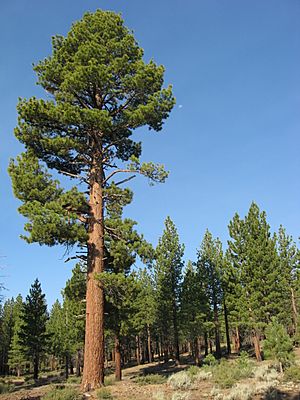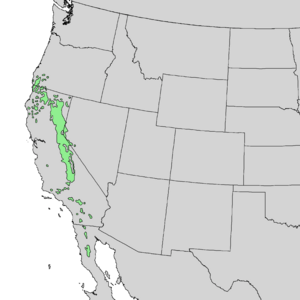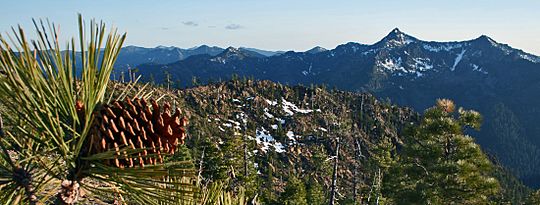Jeffrey pine facts for kids
Quick facts for kids Jeffrey pine |
|
|---|---|
 |
|
| A stand of Pinus jeffreyi growing on volcanic table lands south of Mono Lake, California | |
| Conservation status | |
| Scientific classification | |
 |
The Jeffrey pine (scientific name: Pinus jeffreyi) is a large pine tree found in North America. It grows mostly in California, but also in parts of Nevada, Oregon, and northern Baja California in Mexico. People sometimes call it Jeffrey's pine, yellow pine, or black pine. This tree was named after John Jeffrey, a botanist who studied it.
Contents
What Does the Jeffrey Pine Look Like?
The Jeffrey pine is a big evergreen tree. This means it stays green all year round. It usually grows about 25 to 40 meters (82 to 131 feet) tall. Some can even reach 53 meters (174 feet)! But if it grows high up in the mountains, it might be smaller.
Leaves and Cones of the Jeffrey Pine
The leaves of the Jeffrey pine are like long, stiff needles. They are a grayish-green color. Each bundle has three needles, and they are usually 12 to 23 centimeters (5 to 9 inches) long.
The cones are quite large, about 12 to 24 centimeters (5 to 9 inches) long. When they are young, they are dark purple. As they get older, they turn a pale brown. The scales on the cones have a short, sharp point that curves inward. The seeds inside are small, about 10 to 12 millimeters long, and have a big wing to help them fly away in the wind.
How to Tell Jeffrey Pine from Ponderosa Pine
The Jeffrey pine looks a lot like another tree called the ponderosa pine. But there's a simple trick to tell them apart!
Both trees have cones with sharp points on their scales.
- If you rub your hand down a Jeffrey pine cone, it feels smooth. This is because its sharp points curve inward.
- If you rub your hand down a ponderosa pine cone, it feels prickly. This is because its sharp points stick outward.
A good way to remember this is: "gentle Jeffrey and prickly ponderosa."
Also, Jeffrey pine needles are a duller gray-green than the brighter green of ponderosa pine needles. Jeffrey pine cones are also usually heavier and have bigger seeds. The bark of the Jeffrey pine has smaller scales compared to the larger, reddish plates of ponderosa pine bark.
The Sweet Scent of Jeffrey Pine
One cool thing about the Jeffrey pine is its smell! Many people say its resin smells like vanilla, lemon, pineapple, violets, apple, or even butterscotch. You can smell this by breaking off a small twig or some needles. You can also smell the resin between the bark plates. This special smell comes from a unique chemical in its resin called n-heptane.
The Largest Jeffrey Pine Tree
The biggest Jeffrey pine tree by trunk size is called the Eureka Valley Giant. It lives in the Stanislaus National Forest. Its trunk holds about 4560 cubic feet (129 cubic meters) of wood. This giant tree is 192 feet (58.5 meters) tall and its trunk is 8.1 feet (2.5 meters) wide!
Where Do Jeffrey Pines Grow?
Jeffrey pines grow from southwestern Oregon down through most of California. They are especially common on the eastern side of the Sierra Nevada mountains. Their range extends south into northern Baja California in Mexico.
Jeffrey Pine's Mountain Home
This tree likes to live at high altitudes. In the northern parts of its range, you can find it growing between 1500 to 2100 meters (4,900 to 6,900 feet) high. In the southern parts, it grows even higher, from 1800 to 2900 meters (5,900 to 9,500 feet) up.
Tough Trees for Tough Places
Jeffrey pines are very strong trees. They can handle more stress than ponderosa pines. You often find them in places with poor soil, colder weather, or drier conditions. They are also good at growing in serpentine soil, which is a type of soil that many other plants find hard to grow in. Even in dry, low-altitude areas with serpentine soil, Jeffrey pines can be the main type of tree.

How Are Jeffrey Pines Used?
The wood from Jeffrey pines is very similar to ponderosa pine wood. It is used for many of the same things, like building materials.
Jeffrey Pine Resin and Fuel
The resin from Jeffrey pines is very special because it contains a very pure form of a chemical called n-heptane. This pure n-heptane was chosen as the "zero point" on the octane rating scale for gasoline. The octane rating tells you how well gasoline performs in an engine.
Before 1853, people didn't realize that Jeffrey pine was a different species from ponderosa pine. Back then, people who made turpentine from tree resin sometimes had strange explosions during the process. We now know these explosions happened because they were accidentally using Jeffrey pine resin, which behaves differently due to its unique n-heptane content. This resin is not good for making turpentine.
See also
 In Spanish: Pino de Jeffrey para niños
In Spanish: Pino de Jeffrey para niños


